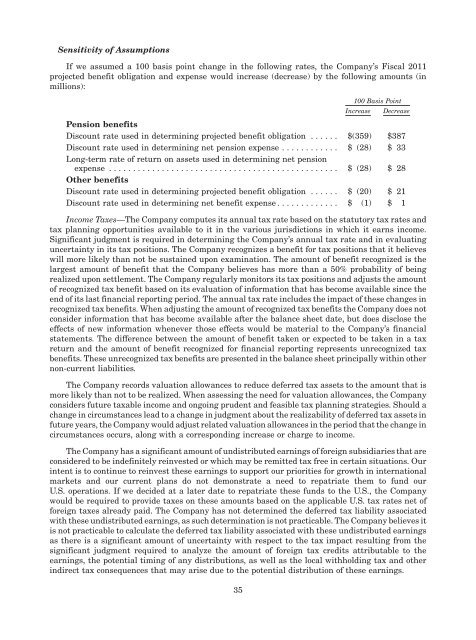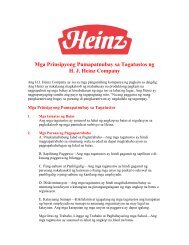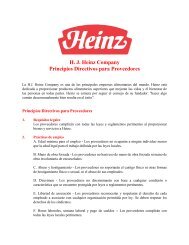Download Annual Report PDF - Heinz
Download Annual Report PDF - Heinz
Download Annual Report PDF - Heinz
Create successful ePaper yourself
Turn your PDF publications into a flip-book with our unique Google optimized e-Paper software.
Sensitivity of Assumptions<br />
If we assumed a 100 basis point change in the following rates, the Company’s Fiscal 2011<br />
projected benefit obligation and expense would increase (decrease) by the following amounts (in<br />
millions):<br />
100 Basis Point<br />
Increase Decrease<br />
Pension benefits<br />
Discount rate used in determining projected benefit obligation . . . . . . $(359) $387<br />
Discount rate used in determining net pension expense . . . . . . . . . . . . $ (28) $ 33<br />
Long-term rate of return on assets used in determining net pension<br />
expense . . . . . . . . . . . . . . . . . . . . . . . . . . . . . . . . . . . . . . . . . . . . . . . . $ (28) $ 28<br />
Other benefits<br />
Discount rate used in determining projected benefit obligation . . . . . . $ (20) $ 21<br />
Discount rate used in determining net benefit expense . . . . . . . . . . . . . $ (1) $ 1<br />
Income Taxes—The Company computes its annual tax rate based on the statutory tax rates and<br />
tax planning opportunities available to it in the various jurisdictions in which it earns income.<br />
Significant judgment is required in determining the Company’s annual tax rate and in evaluating<br />
uncertainty in its tax positions. The Company recognizes a benefit for tax positions that it believes<br />
will more likely than not be sustained upon examination. The amount of benefit recognized is the<br />
largest amount of benefit that the Company believes has more than a 50% probability of being<br />
realized upon settlement. The Company regularly monitors its tax positions and adjusts the amount<br />
of recognized tax benefit based on its evaluation of information that has become available since the<br />
end of its last financial reporting period. The annual tax rate includes the impact of these changes in<br />
recognized tax benefits. When adjusting the amount of recognized tax benefits the Company does not<br />
consider information that has become available after the balance sheet date, but does disclose the<br />
effects of new information whenever those effects would be material to the Company’s financial<br />
statements. The difference between the amount of benefit taken or expected to be taken in a tax<br />
return and the amount of benefit recognized for financial reporting represents unrecognized tax<br />
benefits. These unrecognized tax benefits are presented in the balance sheet principally within other<br />
non-current liabilities.<br />
The Company records valuation allowances to reduce deferred tax assets to the amount that is<br />
more likely than not to be realized. When assessing the need for valuation allowances, the Company<br />
considers future taxable income and ongoing prudent and feasible tax planning strategies. Should a<br />
change in circumstances lead to a change in judgment about the realizability of deferred tax assets in<br />
future years, the Company would adjust related valuation allowances in the period that the change in<br />
circumstances occurs, along with a corresponding increase or charge to income.<br />
The Company has a significant amount of undistributed earnings of foreign subsidiaries that are<br />
considered to be indefinitely reinvested or which may be remitted tax free in certain situations. Our<br />
intent is to continue to reinvest these earnings to support our priorities for growth in international<br />
markets and our current plans do not demonstrate a need to repatriate them to fund our<br />
U.S. operations. If we decided at a later date to repatriate these funds to the U.S., the Company<br />
would be required to provide taxes on these amounts based on the applicable U.S. tax rates net of<br />
foreign taxes already paid. The Company has not determined the deferred tax liability associated<br />
with these undistributed earnings, as such determination is not practicable. The Company believes it<br />
is not practicable to calculate the deferred tax liability associated with these undistributed earnings<br />
as there is a significant amount of uncertainty with respect to the tax impact resulting from the<br />
significant judgment required to analyze the amount of foreign tax credits attributable to the<br />
earnings, the potential timing of any distributions, as well as the local withholding tax and other<br />
indirect tax consequences that may arise due to the potential distribution of these earnings.<br />
35

















